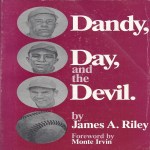Dandy, Day, and the Devil
James A. Riley
Based on exhaustive research and personal interviews, this publication is a trilogy examining the lives and careers of Negro League stars of Ray Dandridge, Leon Day and Willie Wells. Forward by Hall of Famer and former Negro League and Major League star Monte Irvin.
From the Introduction, by Monte Irvin
As the saying goes–There’s a time to live and a time to die, but it is also very important to be in the right place at the right time. It’s called good timing.
If that had happened to Ray Dandridge, Leon Day, and Willie Wells, how different their lives would have been. Not only would they have established many records in organized baseball but would have achieved fame and fortune for themselves and their families. When hot-stove league fans sit around the fire to discuss the game’s greatest performers, their names would be mentioned often and with reverence. In my opinion, they were that good.
But as luck would have it, they were only known by the followers of the Negro League and in all the Latin American countries that featured baseball.
You see, all three of them were at the top of their game during the middle thirties, and by the time Jackie Robinson broke the color barrier in 1946, Branch Rickey overlooked them because age was against them. Consequently, none of them ever experienced the joy of playing Major League Baseball.
Ray Dandridge, better known as “Squatty”, was a born third baseman but could play second and short equally as well. He had the quickest reflexes and the surest hands of any infielder I’ve ever seen. In a season, he had a bad year if he made four errors. As a third baseman, he could field the swinging bunt and get the runner at first better than anyone. It was a thing of beauty and worth the price of admission just to see him make that one particular play.
Most of his career he batted in the number two position because he made real good contact and could hit the ball like a shot to right field on a hit and run situation. Throughout his illustrious career he batted .300 or better.
Next in alphabetical order is Leon Day, the perfect pitcher with blinding speed, great move to first base, and quick as a cat fielding his position. In a must-win situation, the manager always gave the ball to Leon and he failed very few times.
In those important games he would ask his teammages for one run and if they couldn’t do it, he would step up to the plate and do it himself. I comare him to Bob Gibson…
Last, but not least, a few words about Willie Wells, “The Devil,” as he was called. The opposition would always say, “Don’t hit it to shortstop because The Devil is playing out there.”
Willie looked like a star ballplayer-had all the actions of an all-star performer-real good hands, quick as could be, and was an expert on catching the short fly ball hit just over his head. He played in close, and in all situations his throw would just beat the runner to first base. It was a science with him.
He could really run and had a lot of power. He averaged 25 to 30 home runs a season and would hit for a high average. You could get him out with a fastball once in a while but he feasted on curveballs. As a fielder, I’d compare him to Phil Rizzuto–as a hitter–to Ernie Banks.
The major league fans never had the chance to see these great ballplayers perform, and it’s a shame because if they had, they would have never forgotten them.
These fellows were my heroes as I started my career with the Newark Eagles way back in 1937. I don’t think I could have picked a better trio because at that time they were the best.
All three of them deserve induction into the Hall of Fame.
My sincere congratulations to the author for giving them the publicity and promotion that they never received but so richly deserve.
Monte Irvin
National Baseball Hall of Fame





 Follow
Follow
